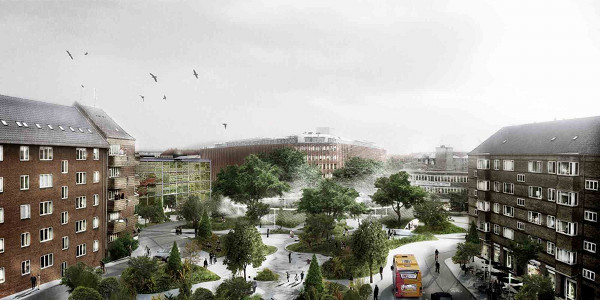All over, it seems, architects are thinking about how to plan for the realities of climate change. Some designers have risen to that challenge by imagining how conventional forms of architecture might become more adaptive and resilient in the face of high water, as in the Skygrove high-rise concept design by HWKN Architects of New York. Other architects, such as those at the Dutch firm Waterstudio.NL, have embraced the Netherlands’ long history of building barriers to hold back rising water for development in recent years by turning their attention to buildings that float, particularly in the nearly sea-level island nation of The Maldives.
But rising sea levels aren’t the only threats posed by climate change. ArchDaily reports that the Copenhagen-based architecture firm Tredje Natur recently presented plans to develop Saint Kjeld’s Quarter into Copenhagen’s greenest (and most resilient) neighborhood by planning for extreme weather events. This comprehensive urban development project is a case-study in planning for rain — lots of it. In this plan, rainwater is managed in the city’s streets in a more natural and effective way via wide range of pragmatic strategies. A key feature here: 20 percent of the neighborhood’s surface area devoted to streets will be reclaimed, creating more green spaces.

This neighborhood design is based on climate modeling that predicts fewer but heavier rain showers for Copenhagen — a phenomenon the city has already observed order the last two summers. Technical and Environmental Mayor of Copenhagen, Ayfer Baykal noted, “The increase in rainfall is a major challenge for our city. But by tackling the challenge the right way, we can secure the city from cloudbursts while also bringing the city new recreational values. The ideas in Saint Kjeld’s Neighborhood are a really good example of this.”
Interested in what those “new recreational values” might consist of? For one, a gigantic floating ring in a public park that uses stored rainwater to spray a cooling mist on hot summer days. This ring not only nurtures hundreds of native plant species on a hilly terrain (slowing the flow of storm water over the site), it invites kids and adults alike to stay and play.

Bicycle paths act as storm water channels. Water towers store rainwater. Green roofs and urban gardens encourage the rain dumped during those big storm events to stick around a while before running off into vegetated canals leading from the neighborhood and out into the harbor. In the process, the neighborhood becomes greener, giving rise to greater biological diversity in the city. By learning how to channel the deluge, so to speak, this neighborhood design rises to the challenge of changing weather patterns while enhancing quality of life for local residents.
The ideas contained in this neighborhood design are just some of the ideas in the works, as Copenhagen plans to transform this densely populated neighborhood into a showcase area for climate adaptation technology. The hope is that it will become a showcase for how to insure cities against the negative consequences of climate change while also significantly improving urban spaces.